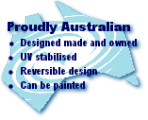There are two types of downpipe diverter filters
These present a mesh barrier across the flow path that traps debris for later removal. Unless they have large surface areas, blockages will decimate harvesting yield and the very worst contaminants, e.g. bird droppings, are mostly washed through to the tank. Entrapment filters high maintenance.
These sacrifice water yield to flush debris and enable a self cleaning function. A water yield of 90% is considered exceptional but poor design and debris bonding to the filter surface severely effects yield.
Divert filters provide cleaner harvested water by eliminating the wash through effect.
The following are major contributors to DIVERT FILTER yield loss and are easy to recognise.
Low percentage open area mesh.
A filter set at a low angle often promotes debris bonding to the mesh.
Filters with blanked sides provide an impenetrable valley along the filter and side wall intersect for water to flow to the drain.
Water flowing down a downpipe can continue down some diverters inner walls. This is due to the natural flow of water down a downpipe’s inner walls, resulting in a lot of water not falling directly on the mesh but splashing onto and flowing over the mesh to the drain.
TO FIND A SOLUTION, WE MUST UNDERSTAND THE PROBLEM!
AQUATREK researched solutions to endemic yield losses and blockages, then used the research data to develop an integrated prototype we now call SUPADIVERTA.
SUPADIVERTA AVERAGE YIELD IS 96%
Divert filters provide cleaner harvested water by eliminating the wash through effect.
The following are major contributors to DIVERT FILTER yield loss and are easy to recognise.
Low percentage open area mesh.
A filter set at a low angle often promotes debris bonding to the mesh.
Filters with blanked sides provide an impenetrable valley along the filter and side wall intersect for water to flow to the drain.
Water flowing down a downpipe can continue down some diverters inner walls. This is due to the natural flow of water down a downpipe’s inner walls, resulting in a lot of water not falling directly on the mesh but splashing onto and flowing over the mesh to the drain.
TO FIND A SOLUTION, WE MUST UNDERSTAND THE PROBLEM!
AQUATREK researched solutions to endemic yield losses and blockages, then used the research data to develop an integrated prototype we now call SUPADIVERTA.
SUPADIVERTA AVERAGE YIELD IS 96%
Supadiverta inlet
The fluent flow through design eliminates dead ending, allowing high volume transfer.
The 20 degree V floor section centralises water flow.
The inlet's ribbed floor stops a `slippery dip’ effect occurring when water flows down one side of a downpipe (which is common). The ribs are also angled to direct water to the centre of the filter.
Supadiverta self cleaning filter
750 micron high percentage open area mesh.
Set at 50 degree angle.
Raised projections on splash platforms prevent debris bonding to the filter mesh.
Filter has raised side walls with inside of wall intersecting the SUPADIVERTA body at a 70 degree angle. This directs water directly onto the filter mesh.
Raised projections on splash platforms prevent debris bonding to the filter mesh.
Filter has raised side walls with inside of wall intersecting the SUPADIVERTA body at a 70 degree angle. This directs water directly onto the filter mesh.
WATER HARVESTING IS AN IMPORTANT CONSERVATION MEASURE THAT IS SUPPORTED BY GOVERNMENT FINANCIAL INCENTIVES. DOWNPIPE DIVERTERS ARE ENCOURAGED BY GOVERNMENT REBATES IN SOME STATES AND THEIR USE IS MANDATORY IN SOME AREAS WHERE CERTAIN CONDITIONS APPLY. AQUATREK BELIEVES A VERIFIED MINIMUM WATER YIELD AND PERFORMANCE RATING SHOULD APPLY TO ELIGIBLE REBATE PRODUCTS. THIS WOULD BENEFIT CONSUMERS, PROMOTE MORE EFFICIENT PRODUCT DESIGN AND DEMONSTRATE WISER USE OF TAXPAYERS MONEY.






